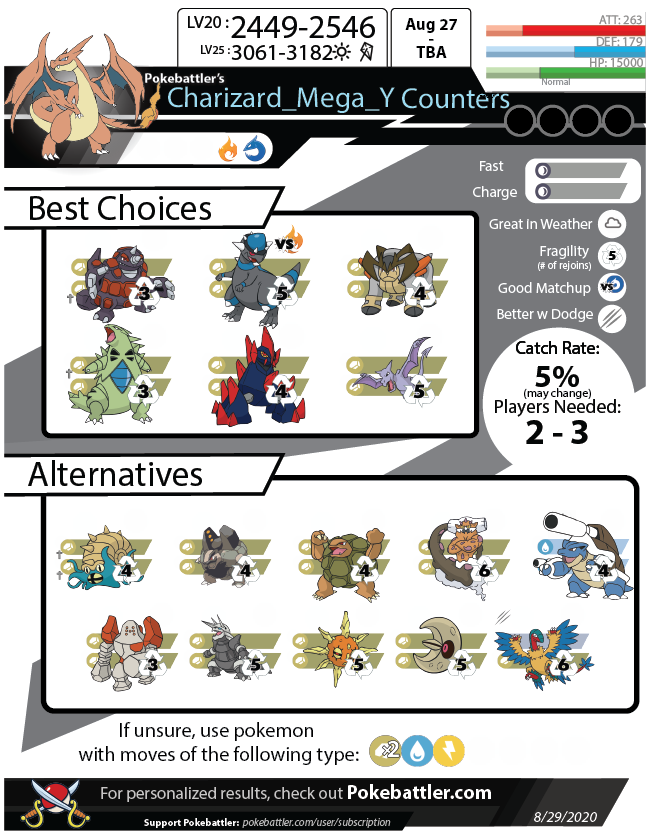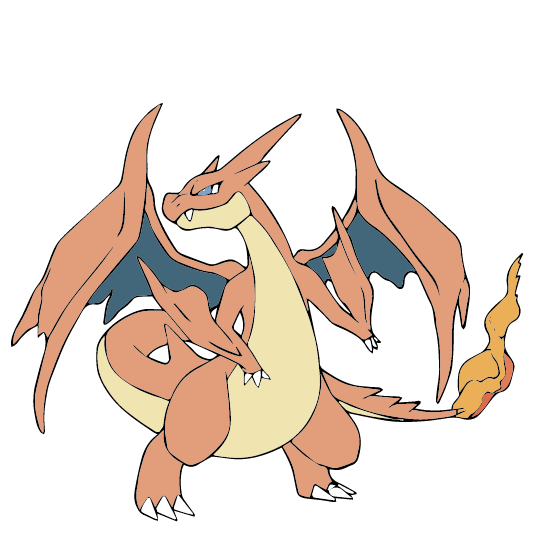Pokémon Go Simulator and Rankings. World's #1 source for detailed Pokémon Go analysis
Kyurem, Reshiram and Zekrom are back in Tier 5 Pokemon Go Raids this December!
Mega Gyarados, Mega Abomasnow and Mega Glalie make their return to Mega Raids.
The Shadow Raid legendary for December is Shadow Heatran! Get your counters ready.
Gigantamax Snorlax is back for another Max Battle Day on December 14th
Join our Discord Server or add Pokebattler to your discord server!
Mega Charizard Y Raid Guide

Mega-Charizard Y Raid Guide

Mega-Charizard Y– Flame Pokémon
Mega-Charizard Y is weak to the following types:
Release History:
- Aug 27 2020 – TBA
Movesets
Sorted Easiest to Hardest.
 Dragon Claw:
Dragon Claw:
 Fire Blast:
Fire Blast: Water-Types are hit for 🛡️ Resistance
Water-Types are hit for 🛡️ Resistance Rock-Types are hit for 🛡️ Resistance
Rock-Types are hit for 🛡️ Resistance
 Overheat:
Overheat: Water-Types are hit for 🛡️ Resistance
Water-Types are hit for 🛡️ Resistance Rock-Types are hit for 🛡️ Resistance
Rock-Types are hit for 🛡️ Resistance
Top Raid Counters

- ⚔️ Raw Damage: ⭐⭐⭐⭐⭐
- 🛡️ Survival/Bulk: ⭐⭐⭐⭐⭐
- 📉 Consistency: ⭐⭐⭐⭐⭐
- 🌐 Accessibility: ⭐⭐⭐⭐⭐
Rhyhorn currently can be found in nests.
With Level 35 Rhyperior you need 2 players.
- Best Estimator VS: Fire Spin/Overheat
- Best Ranking VS: Air Slash/Overheat
- Type Interactions:
- 1× Resists: Fire

- ⚔️ Raw Damage: ⭐⭐⭐⭐⭐
- 🛡️ Survival/Bulk: ⭐⭐☆☆☆
- 📉 Consistency: ⭐⭐⭐☆☆
- 🌐 Accessibility: ⭐☆☆☆☆
Rampardos is very difficult to acquire being fairly new and only having been featured briefly in one quest as Cranidos. its the highest DPS Rock Type.
With Level 35 Rampardos you need 2 players.
- Best Estimator VS: Fire Spin/Overheat
- Best Ranking VS: Air Slash/Fire Blast
- Type Interactions:
- 1× Resists: Fire

- ⚔️ Raw Damage: ⭐⭐⭐⭐⭐
- 🛡️ Survival/Bulk: ⭐⭐⭐⭐☆
- 📉 Consistency: ⭐⭐⭐⭐⭐
- 🌐 Accessibility: ⭐⭐⭐⭐☆
Best Rock Type in terms of survivability and TDO. DPS is usually edged out by the glass cannon Rampardos
With Level 35 Terrakion you need 2 players.
- Best Estimator VS: Air Slash/Overheat
- Best Ranking VS: Air Slash/Overheat
- Type Interactions:
- 1× Resists: Fire

- ⚔️ Raw Damage: ⭐⭐⭐⭐⭐
- 🛡️ Survival/Bulk: ⭐⭐⭐⭐⭐
- 📉 Consistency: ⭐⭐⭐⭐☆
- 🌐 Accessibility: ⭐⭐☆☆☆
Accessibility will be a bit tough if you are only starting now as Larvitars do not nest and are rare. They are also in 10k eggs. Tier 4 Tyranitar Raids were a staple for quite a while, however. Larvitar can be found in ‘Make 3 Excellent Throws in a Row’ Quests. The family was last in raid bosses during Water Festival in Sept 2019. Larvitar community day (the only time you could get Smack Down) was June 2018. It isn’t the highest raw DPS Dark-Type anymore, but it has a ton of bulk on top of near optimal DPS. Weavile and Honchkrow trade with it depending on the matchup.
With Level 35 Tyranitar you need 2 players.
- Best Estimator VS: Fire Spin/Overheat
- Best Ranking VS: Air Slash/Overheat
- Type Interactions:
- 1× Resists: Fire

- ⚔️ Raw Damage: ⭐⭐⭐⭐☆
- 🛡️ Survival/Bulk: ⭐⭐⭐⭐☆
- 📉 Consistency: ⭐⭐⭐⭐⭐
With Level 35 Gigalith you need 3 players.
- Best Estimator VS: Fire Spin/Overheat
- Best Ranking VS: Air Slash/Overheat
- Type Interactions:
- 1× Resists: Fire

- ⚔️ Raw Damage: ⭐⭐⭐⭐☆
- 🛡️ Survival/Bulk: ⭐⭐⭐☆☆
- 📉 Consistency: ⭐⭐⭐⭐⭐
- 🌐 Accessibility: ⭐⭐⭐⭐☆
Aerodactyl is an occasional 3 star raid boss, and possible reward in the “Evolve a Pokemon Using an Item” and “complete five Raids” Quests. 10k Egg Hatch.
With Level 35 Aerodactyl you need 3 players.
- Best Estimator VS: Fire Spin/Overheat
- Best Ranking VS: Air Slash/Overheat
- Type Interactions:
- 1× Resists: Fire
Weather
Here is a list of Pokemon that can perform similar or better than the typical #1 option (in this case, Rhyperior) with weather bonuses:| Pokemon | Weather | Fast Move | Charge Move | Estimator |
|---|---|---|---|---|
 Rhyperior Rhyperior | ⛅️Partly Cloudy | 1.4 | ||
 Terrakion Terrakion | ⛅️Partly Cloudy | 1.5 | ||
 Rampardos Rampardos | ⛅️Partly Cloudy | 1.5 | ||
 Tyranitar Tyranitar | ⛅️Partly Cloudy | 1.6 | ||
 Gigalith Gigalith | ⛅️Partly Cloudy | 1.7 |
Alternate Pokemon

Alternative Charge Moves: ROCK_BLAST
- ⚔️ Raw Damage: ⭐⭐⭐⭐☆
- 🛡️ Survival/Bulk: ⭐⭐⭐⭐☆
- 📉 Consistency: ⭐⭐⭐⭐⭐
One of the absolute oldest legacy moves and extremely unlikely to ever return. Omastar has never been able to learn this moveset in the main games. Omanyte currently can be found in nests.
With Level 35 Omastar you need 3 players.
- Best Estimator VS: Air Slash/Dragon Claw
- Best Ranking VS: Fire Spin/Overheat
- Type Interactions:
- 2× Resists: Fire

Alternative Charge Moves: ROCK_BLAST
- ⚔️ Raw Damage: ⭐⭐⭐☆☆
- 🛡️ Survival/Bulk: ⭐⭐⭐☆☆
- 📉 Consistency: ⭐⭐⭐⭐☆
Alolan Geodude can be found in the wild and in 7k eggs. To get a 7k egg. 7k Eggs are added at random from opening gifts when you have an open Egg Inventory Slot, and when hatched will be marked as the location where the Gift originated from. Alolan Geodude were incredibly common during the 3rd Anniversary Pokemon Go Event. Alolan Geodude spawn from Magnetic Lure Modules as well.
With Level 35 Golem-Alola you need 3 players.
- Best Estimator VS: Fire Spin/Overheat
- Best Ranking VS: Air Slash/Overheat
- Type Interactions:
- 1× Resists: Fire

Alternative Charge Moves: ANCIENT_POWER ROCK_BLAST
- ⚔️ Raw Damage: ⭐⭐⭐☆☆
- 🛡️ Survival/Bulk: ⭐⭐⭐☆☆
- 📉 Consistency: ⭐⭐⭐⭐☆
Geodude are not too much of a pain to acquire for most people and exist in research rewards as well. Hunt down a nest or play in partly cloudy will be enough for many to get Golem. Geodude can be in “Make 5 Nice Throws” quests.
With Level 35 Golem you need 3 players.
- Best Estimator VS: Fire Spin/Overheat
- Best Ranking VS: Air Slash/Overheat
- Type Interactions:
- 1× Resists: Fire

- ⚔️ Raw Damage: ⭐⭐⭐⭐☆
- 🛡️ Survival/Bulk: ⭐⭐☆☆☆
- 📉 Consistency: ⭐⭐⭐☆☆
With Level 35 Landorus you need 3 players.
- Best Estimator VS: Fire Spin/Overheat
- Best Ranking VS: Air Slash/Dragon Claw
- Type Interactions:
- No Type Interactions

- ⚔️ Raw Damage: ⭐⭐⭐☆☆
- 🛡️ Survival/Bulk: ⭐⭐⭐☆☆
- 📉 Consistency: ⭐⭐⭐⭐☆
Squirtle currently can be found in nests.
With Level 35 Mega-Blastoise you need 3 players.
- Best Estimator VS: Air Slash/Overheat
- Best Ranking VS: Fire Spin/Overheat
- Type Interactions:
- 1× Resists: Fire

- ⚔️ Raw Damage: ⭐⭐☆☆☆
- 🛡️ Survival/Bulk: ⭐⭐⭐⭐⭐
- 📉 Consistency: ⭐⭐⭐⭐⭐
With Level 35 Regirock you need 3 players.
- Best Estimator VS: Air Slash/Fire Blast
- Best Ranking VS: Air Slash/Overheat
- Type Interactions:
- 1× Resists: Fire

- ⚔️ Raw Damage: ⭐⭐☆☆☆
- 🛡️ Survival/Bulk: ⭐⭐☆☆☆
- 📉 Consistency: ⭐⭐☆☆☆
With Level 35 Aggron you need 3 players.
- Best Estimator VS: Fire Spin/Overheat
- Best Ranking VS: Fire Spin/Dragon Claw
- Type Interactions:
- 1× Resists: Dragon
- Canceled Out: Fire

- ⚔️ Raw Damage: ⭐⭐☆☆☆
- 🛡️ Survival/Bulk: ⭐⭐☆☆☆
- 📉 Consistency: ⭐⭐⭐⭐⭐
With Level 35 Solrock you need 3 players.
- Best Estimator VS: Fire Spin/Dragon Claw
- Best Ranking VS: Air Slash/Overheat
- Type Interactions:
- 1× Resists: Fire

- ⚔️ Raw Damage: ⭐⭐☆☆☆
- 🛡️ Survival/Bulk: ⭐⭐☆☆☆
- 📉 Consistency: ⭐⭐⭐⭐⭐
With Level 35 Lunatone you need 3 players.
- Best Estimator VS: Fire Spin/Dragon Claw
- Best Ranking VS: Air Slash/Overheat
- Type Interactions:
- 1× Resists: Fire

- ⚔️ Raw Damage: ⭐⭐⭐☆☆
- 🛡️ Survival/Bulk: ⭐☆☆☆☆
- 📉 Consistency: ⭐⭐⭐☆☆
With Level 35 Archeops you need 3 players.
- Best Estimator VS: Fire Spin/Overheat
- Best Ranking VS: Air Slash/Dragon Claw
- Type Interactions:
- 1× Resists: Fire

Alternative Charge Moves: SURF
- ⚔️ Raw Damage: ⭐⭐☆☆☆
- 🛡️ Survival/Bulk: ⭐⭐⭐☆☆
- 📉 Consistency: ⭐⭐⭐⭐☆
With Level 35 Carracosta you need 3 players.
- Best Estimator VS: Air Slash/Dragon Claw
- Best Ranking VS: Fire Spin/Overheat
- Type Interactions:
- 2× Resists: Fire

- ⚔️ Raw Damage: ⭐⭐☆☆☆
- 🛡️ Survival/Bulk: ⭐⭐☆☆☆
- 📉 Consistency: ⭐⭐⭐⭐⭐
With Level 35 Zekrom you need 3 players.
- Best Estimator VS: Fire Spin/Dragon Claw
- Best Ranking VS: Air Slash/Overheat
- Type Interactions:
- 1× Resists: Fire
- 1× Weak: Dragon

Alternative Charge Moves: HYDRO_PUMP
- ⚔️ Raw Damage: ⭐⭐☆☆☆
- 🛡️ Survival/Bulk: ⭐⭐⭐☆☆
- 📉 Consistency: ⭐⭐⭐⭐☆
- 🌐 Accessibility: ⭐⭐☆☆☆
Kyogre was first available January 2018. It is the premier Water-Type attacker and an incredibly powerful attacker. Someday it will likely be outclassed by itself if Niantic gives it the move Origin Pulse.
With Level 35 Kyogre you need 3 players.
- Best Estimator VS: Air Slash/Overheat
- Best Ranking VS: Air Slash/Overheat
- Type Interactions:
- 1× Resists: Fire

Alternative Charge Moves: STONE_EDGE
- ⚔️ Raw Damage: ⭐⭐☆☆☆
- 🛡️ Survival/Bulk: ⭐⭐☆☆☆
- 📉 Consistency: ⭐⭐⭐⭐☆
Sudowoodo currently can be found in nests.
With Level 35 Sudowoodo you need 3 players.
- Best Estimator VS: Fire Spin/Overheat
- Best Ranking VS: Air Slash/Overheat
- Type Interactions:
- 1× Resists: Fire

Alternative Charge Moves: ROCK_BLAST
- ⚔️ Raw Damage: ⭐⭐☆☆☆
- 🛡️ Survival/Bulk: ⭐☆☆☆☆
- 📉 Consistency: ⭐⭐☆☆☆
With Level 35 Crustle you need 3 players.
- Best Estimator VS: Air Slash/Overheat
- Best Ranking VS: Air Slash/Dragon Claw
- Type Interactions:
- Canceled Out: Fire

Alternative Fast Moves: AIR_SLASH_FAST
- ⚔️ Raw Damage: ⭐☆☆☆☆
- 🛡️ Survival/Bulk: ⭐☆☆☆☆
- 📉 Consistency: ⭐⭐⭐☆☆
With Level 35 Rayquaza you need 3 players.
- Best Estimator VS: Air Slash/Dragon Claw
- Best Ranking VS: Fire Spin/Overheat
- Type Interactions:
- 1× Resists: Fire
- 1× Weak: Dragon

Alternative Fast Moves: FURY_CUTTER_FAST
Alternative Charge Moves: STONE_EDGE
- ⚔️ Raw Damage: ⭐☆☆☆☆
- 🛡️ Survival/Bulk: ⭐⭐☆☆☆
- 📉 Consistency: ⭐⭐⭐⭐⭐
Kabuto currently can be found in nests.
With Level 35 Kabutops you need 3 players.
- Best Estimator VS: Fire Spin/Overheat
- Best Ranking VS: Fire Spin/Overheat
- Type Interactions:
- 2× Resists: Fire
Miscelaneous Analysis
[under construction]Pokebattler Now has a Merch Store Check it out Below:
[Merch Store]
You can also support by taking up a Subscription!
[Subscribe]
Latest PvP News!
Articles and Videos From Top PvP Players























©2016-2022 Pokebattler.com™. All rights reserved by their respective owners.
Pokebattler™ is not officially affiliated with Pokémon Go and is intended to fall under Fair Use doctrine, similar to any other informational site such as a wiki.
All Pokémon Go trademarks, copyrights etc are held by Niantic, Inc.; Pokémon; and Nintendo / Creatures Inc. / GAME FREAK inc. Pokémon and Pokémon character names are trademarks of Nintendo.

